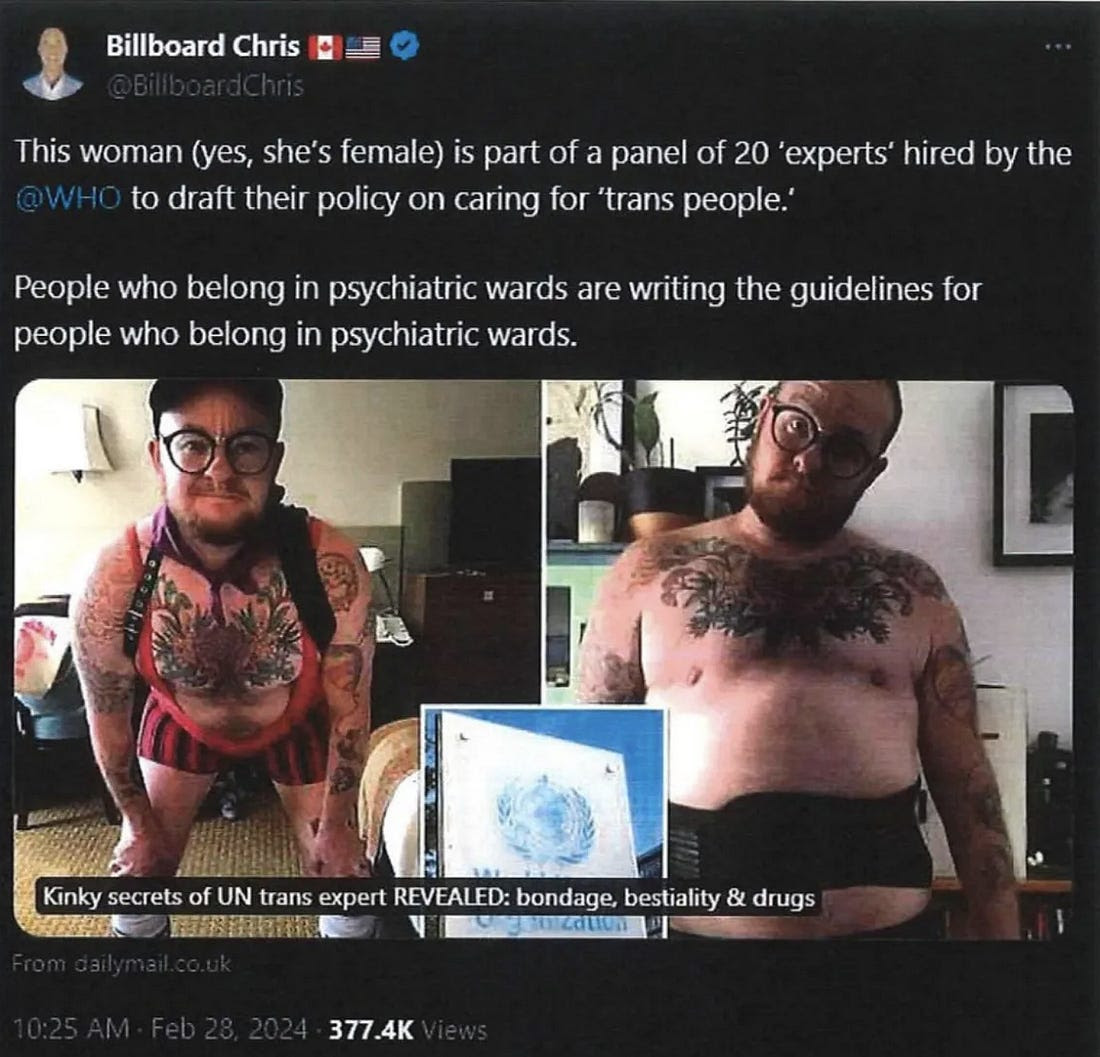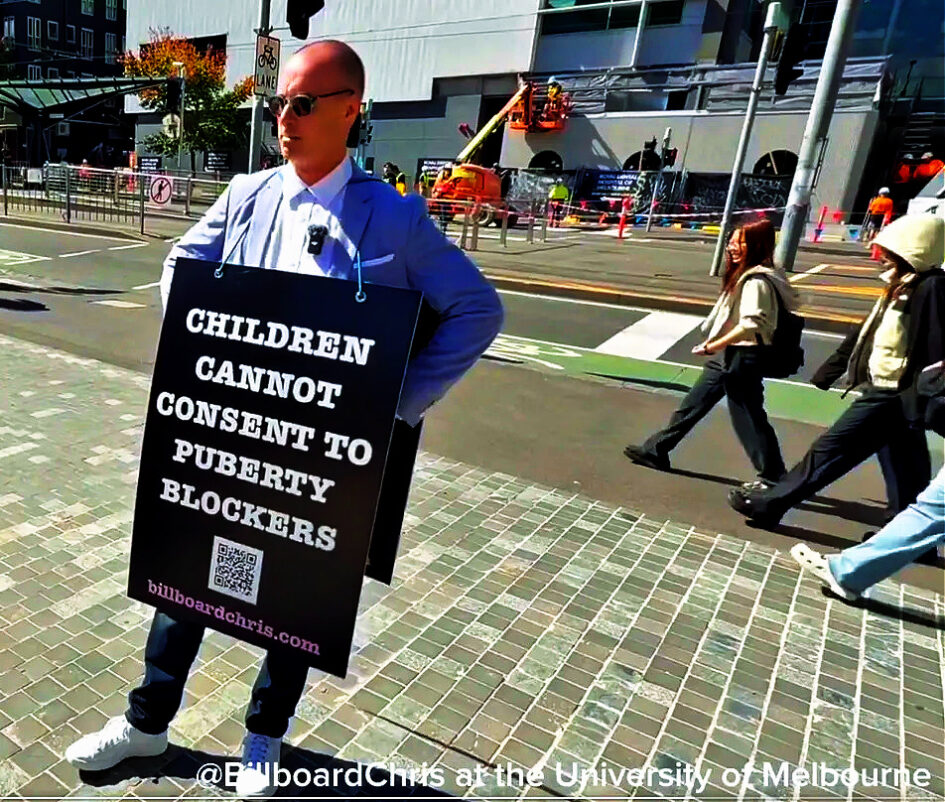From Rebekah Barnett: Dystopian Down Under
Do people have the right to participate in charged social debates online?
This is the question at the heart of a lawsuit between Australia’s online harms regulator, the eSafety Commissioner, on one side, with gender critical activist Chris Elton (aka Billboard Chris) and social media platform X on the other.
eSafety says no, on the basis that frank online discussion of gender ideology, including use of a pronoun relating to a trans-identified person’s biological sex (called ‘misgendering’) can cause “serious harm.”
Elston and X say yes, on the basis that political debate in public spaces is not only lawful, but essential.
eSafety vs. Elston and X (two separate cases being heard together), heard at the Administrative Review Tribunal (ART) in Melbourne this week, will serve as a test of the limits of eSafety’s regulatory powers in censoring online speech during an era where Western governments are increasingly seeking to control public discourse under the justification of harm reduction.
With closing arguments done and dusted, we now wait for a decision, which I’m told could take up to several months.
Meanwhile, the five-day hearing demonstrated the futility of trying to censor active political debate on contested social issues. Read on for a wrap-up of the week:
The case
First, a quick backgrounder (skip down to the wrap up if you’re already across this). In this case, the argument hinges on whether “an ordinary reasonable person” would conclude that a social media post made to X by Elston in February last year was “intended to cause serious harm to the Complainant,” who is the subject of the post, which can be seen below.

eSafety demanded that X remove this post under Section 88 of the Online Safety Act 2021 (OSA), alleging that it constituted adult cyber abuse. X and Elston challenged the order in court, culminating in last week’s ART hearings. Notably, Elston is not Australian — he is Canadian — but Cook is.
More on what this case is all about, here:
Hearing wrap up
During the week, there was much semantic backing and forthing over questions like what is an “ordinary, reasonable person,” how such a person might determine the intent behind Elston’s social media post, and how the threshold for “serious harm“ might be assessed in the absence of a clinically recognised condition relating to this term used in the relevant legislation.
Experts were wheeled in to hold forth on whether it is or is not offensive to use biologically accurate pronouns, how to assess whether someone has been harmed by a tweet, whether or not Elston should be held responsible for the contents of a Daily Mail article linked to in his post when other X users weren’t, and so on.
Case in point, one of eSafety’s expert witnesses, Professor of Digital Communications at RMIT, Rob Cover, whose expert report cost Australian taxpayers a cool $9,100.
Prof Cover is a former teacher of mine. I took his professional writing unit during my communications degree at the University of Western Australia and I found him to be warm, sincere, invested in his students, and steeped in the literature of the field, including critical theory (which I was also steeped in as a student).
Brought in as an expert on digital harm and gender/sexual diversity in screen contexts, Prof Cover told the Tribunal that using sex-based language is “misgendering,” “harmful,” and “anti-science,” a position he considered to be informed by science and by “the truth of the person which wishes to be identified in that way in accordance with their reality.”
He said that referring to a trans-identified person’s “biological identity noted on the birth certificate” would be ”misgendering and transphobic” unless in a medical setting.
As a former student of Prof Cover’s and the academic literature he is versed in, I totally get how an academic could genuinely believe his testimony to the Tribunal, and I have no doubt he meant it sincerely.
Yes his position, which he holds to be “common sense,” is nonsensical to others – including ordinary Australians and experts in other fields, like evolutionary biologists, for example.
Another vignette underscoring the subjective nature of the exercise:
Team eSafety went in circles for quite a long time trying to get Elston to admit that his post was intended to provoke trans activist Teddy Cook and to incite outrage.
Under questioning, Elston repeated, over and over, that his post was intended to provoke discussion and awareness. This seems obvious – Elston has been traveling the world for years campaigning against paediatric gender medicine.
Moreover, it was highlighted by Team X that Elston tagged the World Health Organisation’s (WHO) handle but not Cook’s, suggesting that Elston’s intent was to speak to the political debate around how the WHO selects the teams informing its care guidelines.
Further discussion was had about Elston’s evidence-backed assertion that many trans-identified individuals suffer from psychiatric comorbidities, with Team eSafety trying to draw out an admission from Elston that he had diagnosed Cook as such from afar (it didn’t work, as he maintained that he had no position on Cook’s individual psychiatric diagnoses or lack thereof).
However, within a movement that reflexively calls anyone who speaks frankly or disagrees a bigot, there is a tendency to perceive everything as a personal attack, a line that Team eSafety persisted with long past the point of feasibility.
Ultimately, the week of hearings underscored that where significant disagreements exist among lay people and experts, interference from overeager government agencies is not only futile, but is bound to fuel polarisation and social frustration.
Whether the judge’s decision will fall in favour of online censorship or open public debate remains to be seen. Either way, it will mark a precedent should the eSafety Commissioner wish to again interfere with political debate.
Created in 2015 to protect children from online harms, such as getting child sex abuse content swiftly removed from the internet, the remit of office of the eSafety Commissioner has expanded over the years under Julie Inman Grant’s leadership to address issues like image-based abuse (revenge porn), online bullying, and more recently, adult cyber abuse.
It is the latter program under which eSafety has repeatedly strayed into censoring political debate, forcing the removal of social media posts on breast-feeding, trans-identified people in sports, and alleged misgendering.
Professor Emeritus Patrick Parkinson, a family law academic from the University of Queensland who was called upon as a witness during proceedings, summed up the moderate position on eSafety’s evolution in a post made to X:
“Although I was called to give evidence by team Elston, I made it clear that I support the e-Safety Commissioner’s work in general, especially in protecting kids from harmful online content.
“However, the power to censor adult conversations must be used sparingly and the threshold for doing so must be high. Did we not all learn that during the pandemic? What terrible wrongs the censors did at that time, including those employed by Twitter.”
Others are calling for eSafety to be abolished altogether.
Meanwhile, a recent statutory review of eSafety’s OSA legislation resulted in 67 recommendations to “strengthen Australia’s online safety laws,” which, if implemented, will see eSafety’s remit, powers, and resources expand.
With thanks to Free Speech Union (FSU) Australia and Elston’s legal representatives ADF International for their coverage on X, as I was only able to stream into part of the hearings, and recordings and transcripts have not been made available.
Rebekah Barnett is one of the most talented of a new wave of young Australian journalists to come to the fore during the Covid era. You can follow her work HERE. She also regularly publishes in the journal of one of the world’s leading think tanks, the Brownstone Institute, HERE.



